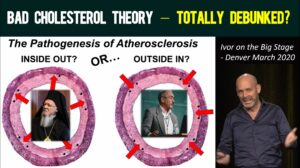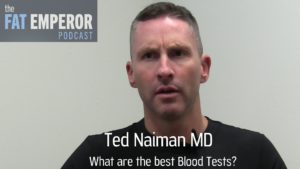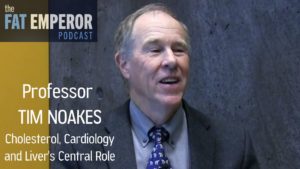Physician’s for Ancestral Health have just released my talk from their Miami Retreat last month. You want to go a little deeper on the mechanisms of Hyperinsulinemia/IR? Ok then – here you go.
With special thanks to Gabor Erdosi of the Lower Insulin facebook group – he has single-handedly decoded the early stages of this universal dysfunctional state. Yep folks – It all starts in the adipose tissue!
For cardiac disease prevention, please see the superb Widowmaker Movie short version here ! https://www.youtube.com/watch?v=NSPcuGjstN4&t=112s
Slides available here:
Roads to Ruin Slidepack
A small subset of some papers which were important to analyse before delivering this talk:
Imbalanced insulin action in chronic over nutrition: Clinical harm, molecular mechanisms, and a way forward Atherosclerosis 247 (2016) 225e282
Insulin resistance, lipotoxicity, type 2 diabetes and atherosclerosis: the missing links. The Claude Bernard Lecture 2009Diabetologia (2010) 53:1270–1287
Direct Hepatocyte Insulin Signaling Is Required for Lipogenesis but Is Dispensable for the Suppression of Glucose Production Titchenell et al., 2016, Cell Metabolism 23, 1–13
SULF2 Strongly Predisposes to Fasting and Postprandial Triglycerides in Patients with Obesity and Type 2 Diabetes Mellitus Obesity (Silver Spring). 2014 May ; 22(5): 1309–1316.
SULF-2: AN EXTRACELLULAR MODULATOR OF CELL SIGNALING AND A CANCER TARGET CANDIDATE Expert Opin Ther Targets. 2010 September ; 14(9): 935–949.
De novo lipogenesis in the liver in health and disease: more than just a shunting yard for glucose Biological Reviews 91 (2016) 452–468
PKC-θ knockout mice are protected from fat-induced insulin resistance J. Clin. Invest. 114:823–827 (2004).
Protein kinase Cdeficiency attenuates obesity syndrome of ob/ob mice by promoting white adipose tissue remodelingJournal of Lipid Research Volume 53, 2012
Inhibition of PKC¯ Improves Glucocorticoid-Induced Insulin Resistance in Rat AdipocytesLife, 54: 365–370, 2002
Obesity and insulin resistanceThe Journal of Clinical Investigation | August 2000 | Volume 106 | Number 4
Adipocyte dysfunctions linking obesity to insulin resistance and type 2 diabetes molecular cell biology volume 9May 2008
Increased glucose uptake promotes oxidative stress and PKC- activation in adipocytes of obese, insulin-resistant mice Am J Physiol Endocrinol Metab 285: E295–E302, 2003
Adipose-selective targeting of the GLUT4 gene impairs insulin action in muscle and liver NATURE |VOL 409 | 8 FEBRUARY 2001 |www.nature.com
Disruption of Adipose Rab10-Dependent Insulin Signaling Causes Hepatic Insulin Resistance Diabetes Publish Ahead of Print, published online March 25, 2016
A novel ChREBP isoform in adipose tissue regulates systemic glucose metabolism 9A P R I L2 0 1 2 VO L 4 8 4 N AT U R E
Normal muscle glucose uptake in mice deficient in muscle GLUT4 Journal of Endocrinology (2012) 214, 313–327
Adipose tissue mTORC2 regulates ChREBP-driven de novo lipogenesis and hepatic glucose metabolism NATURE COMMUNICATIONS | 7:11365 | DOI: 10.1038/ncomms11365
De novo lipogenesis in human fat and liver is linked to ChREBP-b and metabolic health NATURE COMMUNICATIONS | 4:1528 | DOI: 10.1038/ncomms2537 |www.nature.com/naturecommunications
Downregulation of Adipose Tissue Fatty Acid Trafficking in Obesity A Driver for Ectopic Fat Deposition? DIABETES, VOL. 60, JANUARY 2011
Excessive caloric intake acutely causes oxidative stress, GLUT4 carbonylation, and insulin resistance in healthy men www.ScienceTranslationalMedicine.org 9 September 2015 Vol 7 Issue 304 304re7
GLUT4 Expression in Adipocytes Regulates De Novo Lipogenesis and Levels of a Novel Class of Lipids With Antidiabetic and Anti-inflammatory Effects Diabetes 2016;65:1808–1815
Identification of a Lipokine, a Lipid Hormone Linking Adipose Tissue to Systemic MetabolismCell. 2008 September 19; 134(6): 933–944.
Targeted Overexpression of Inducible 6-Phosphofructo-2-kinase in Adipose Tissue Increases Fat Deposition but Protects against Diet-induced Insulin Resistance and Inflammatory Responses* THE JOURNAL OF BIOLOGICAL CHEMISTRY VOL. 287, NO. 25, pp. 21492–21500, June 15, 2012
Insulin Resistance – A Multifaceted Syndrome Responsible for NIDDM, Obesity, Hypertension, Dyslipidemia, and Atherosclerotic Cardiovascular Disease DIABETES CARE, VOL. 14, NO. 3, MARCH 1991
Excess exposure to insulin may be the primary cause of insulin resistance Am J Physiol EndocrinolMetab 298: E372, 2010
Excess exposure to insulin (glargine) induces type 2 diabetes mellitus in mice on chow diet. Journal of Endocrinology (2014) 221, 469–480
Skeletal Muscle Insulin Resistance in Normoglycemic Subjects With a Strong Family History of Type 2 Diabetes Is Associated With Decreased Insulin-Stimulated Insulin Receptor Substrate-1 Tyrosine Phosphorylation DIABETES, VOL. 50, NOVEMBER 2001
Adipocyte dysfunctions linking obesity to insulin resistance and type 2 diabetes Nat Rev MolCell Biol. 2008 May ; 9(5): 367–377.
Adipose tissue dysregulation and reduced insulin sensitivity in non-obese individuals with enlarged abdominal adipose cellsHammarstedt et al. Diabetology & Metabolic Syndrome 2012, 4:42
Impaired (‘diabetic’) insulin signaling and action occur in fat cells long before glucose intolerance—is insulin resistance initiated in the adipose tissue? International Journal of Obesity (2002) 26, 897–904
Arachidonic acid has a dominant effect to regulate lipogenic genes in 3T3-L1 adipocytes compared to omega-3 fatty acidsFood & Nutrition Research 2015, 59: 25866
Omega-6 polyunsaturated fatty acids and the early origins of obesity Curr Opin Endocrinol Diabetes Obes 2013, 20:56–61
The pathogenesis of insulin resistance: integrating signaling pathways and substrate flux J ClinInvest. 2016;126(1):12–22.
Hepatic Acetyl CoA Links Adipose Tissue Inflammation to Hepatic Insulin Resistance and Type 2 DiabetesPerry et al., 2015, Cell 160, 1–14
Insulin-independent regulation of hepatic triglyceride synthesis by fatty acidsPNAS | January 27, 2015 | vol. 112 | no. 4 | 1143–1148
Plasma non-esterified fatty acids: why are we not measuring them routinely? Ann Clin Biochem 2005; 42: 413–414
Impaired Free Fatty Acid Suppression During Hyperinsulinemia Is a Characteristic Finding in Familial Combined Hyperlipidemia, but Insulin Resistance Is Observed Only in Hypertriglyceridemic Patients Arterioscler Thromb Vasc Biol. 2000;20:164-170.)
Direct Hepatocyte Insulin Signaling Is Required for Lipogenesis but Is Dispensable for the Suppression of Glucose Production Titchenell et al., 2016, Cell Metabolism 23, 1–13
Glucose and Free Fatty Acid Metabolism in Non-insulin-dependent Diabetes Mellitus J. Clin. Invest. Volume 84, July 1989, 205-213
The effects of free fatty acids on gluconeogenesis and glycogenolysis in normal subjectsJ. Clin. Invest. 103:365–372 (1999).
Effects of Free Fatty Acid Elevation on Postabsorptive Endogenous Glucose Production and Gluconeogenesis in Humans DIABETES, VOL. 49, MAY 2000
Effects of Free Fatty Acids Per Se on Glucose Production, Gluconeogenesis, and Glycogenolysis DIABETES, VOL. 52, FEBRUARY 2003
Free Fatty Acid as a link in the Regulation of Hepatic Glucose Output by Peripheral InsulinDIABETES, VOL. 44, SEPTEMBER 1995
Stearoyl-CoA desaturase and insulin signaling — What is the molecular switch? Biochimica et Biophysica Acta 1797 (2010) 1189–1194
Hepatic lipogenesis independent of insulin in type 2 diabetes mellitus—a paradox clarifiedProc. Natl Acad. Sci. USA doi:10.1073/pnas.1423952112
Metabolic Syndrome and Insulin Resistance: Underlying Causes and Modification by Exercise TrainingCompr Physiol. 2013 January ; 3(1): 1–58.
Lipid-Induced Insulin Resistance in Skeletal Muscle: The Chase for the Culprit Goes from Total Intramuscular Fat to Lipid Intermediates, and Finally to Species of Lipid IntermediatesNutrients 2016, 8, 466
Fatty Acids, Obesity, and Insulin Resistance: Time for a ReevaluationDIABETES, VOL. 60, OCTOBER 2011
Impaired (‘diabetic’) insulin signaling and action occur in fat cells long before glucose intolerance—is insulin resistance initiated in the adipose tissue? International Journal of Obesity (2002) 26, 897 – 904.







